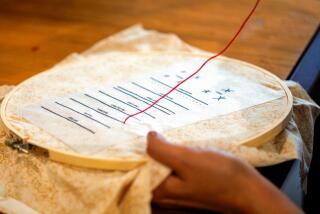Here, It’s Quilt by Association
- Share via
So how do you make an American Quilt?
The pursuit of the finer points of quilting has brought nearly 400 enthusiasts from throughout the United States to the Concordia University campus in the hills of south Irvine.
They have come to Camp Watch-A-Patcher, a summer camp for quilters held every two years by the 15-year-old Orange County Quilters Guild.
“I was a biology major, and then I discovered quilting,” Santa Ana quilter Christine Gill said. “I had never sewn a stitch before in my life. It’s been 10 years and I can’t stop.”
During the five-day event, quilters gather at workshops taught by experts on subjects ranging from the creation of miniature landscapes with hand-dyed fabrics to machine-guided quilting.
“It’s an obsession,” said 23-year quilter Pat McCarten, who traveled from the Kern County city of Ridgecrest with two friends for the weeklong series of workshops and lectures. “It’s a social activity as well as an obsession. We go shopping together and we go to quilt shows and we have quilting programs. We put a lot of ourselves and our lives into our work.”
There are degrees of dedication among quilters. Some will not use a sewing machine for any part of the quilt, insisting that all the stitches be done by hand. It can be a daunting task, considering the complexity of some designs. Some highly crafted antique quilts have sold for more than $200,000.
“There were times when quilt makers would actually pick out the threads from garments they had thrown together, to reuse that thread,” said Fern Plett, a charter member of the county guild who makes quilts for her seven grandchildren. “There are some purists who still do those kinds of things.”
On odd-numbered years, the guild has summer quilt shows where members show off their work.
It is not uncommon for a quilt to take several years to complete, according to Claudia Redfern, a former guild president who organized the summer quilting camp. Redfern has been quilting for 18 years but says she still has a lot to learn.
“There are so many applications: You can have hand-piecing, you can have applique, you can have machine quilting. A good way to learn quilting is to go back to the traditional way prior to the invention of the sewing machine, where quilts were made by hand for the purpose of keeping warm. People recycled flour and rice sacks, dresses and old clothes to make warm comforters as they came west on the Mormon Trail.”
For workshop teacher Elly Sienkiewicz, a Washington, D.C., resident, the Irvine quilting camp is but one of many seminars she has taught around the world during the last 11 years.
“I believe this is becoming the golden age of quilting again as it was in the late 19th century,” said Sienkiewicz, who sees the art as an act of cultural expression.
“It ties us to our past, gives us stability in the present and gives us hope for the future.”


